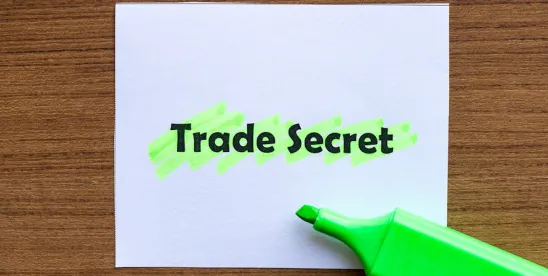Legal regimes are shifting, including in the intellectual property world as businesses increasingly seek the protection of trade secrets rather than patents to secure their confidential information. When the Defend Trade Secrets Act was passed in 2016, trade secret litigation skyrocketed, increasing more than 25 percent in a single year. While the number of trade secret cases filed in federal court fell briefly during COVID, that number is back on the rise, with over 1,200 cases filed last year. Meanwhile, patent litigation is experiencing the opposite trend: the number of patent cases filed in 2023 fell to their lowest levels since 2010. These trends highlight a shift in how businesses are protecting their companies’ confidential information that reflects an increased desire for comprehensive yet informal protection.
Patents and trade secrets differ in the scope and type of protection for protected information. Patents defend inventions by granting exclusive use to their owner. To receive a twenty-year monopoly, the owner must be the first inventor to file a public application describing a useful, new, and non-obvious process, machine, manufacture, or composition of matter. Trade secrets, on the other hand, derive their independent economic value from that very non-disclosure of information. To trigger this protection, the information must be subject to reasonable efforts to maintain secrecy. Because they are not officially registered, trade secrets are defined by the extent to which the information is known outside and within the business, the measures developed to prevent inadvertent or purposeful disclosure, the value of the secrets to competitors, the time and resources spent in developing the information, and the ease of duplication. Protection of the information is perpetual as long as the information remains secret.
The recent litigation trends show that rather than depending on the limited use monopoly of patents, companies and inventors are targeting the longer-term protection of trade secrets. There are several reasons for this shift.
First, the Defend Trade Secrets Act of 2016 (“DTSA”) codified trade secret misappropriation as a federal crime, permitting owners to file in federal court without requiring diversity jurisdiction. The Act defines “trade secret” broadly and describes various types of misappropriation, making it easier for litigants to establish protection and misappropriation. Litigants welcome this clarity, especially compared to the increasing uncertainty regarding patent validity following the passage of the America Invents Act. Moreover, patents have become easier to invalidate as abstract ideas under Section 101 of the Patent Act. Doctrinal uncertainty on patent validity questions has made patent protection less certain.
Second, the rise in lawsuits for trade secret misappropriation has been fueled by the potential for larger damages awards in trade secret cases than patent cases, encouraging litigants to bring trade secret cases. For example, in Comet Technologies USA Inc. v. XP Power LLC, No. 5:20cv-06408-NC, ECF No. 406 (N.D. Cal. Mar. 23, 2022), the jury awarded $40 million in compensatory and punitive damages for poaching Comet employees who absconded with its proprietary technologies. DTSA’s provision for unjust enrichment damages, or damages related to avoided costs, have contributed to this increase.
Third, injunctive relief provides litigants with swift relief against misappropriation. Courts have liberally granted such relief in trade secret cases – often without even requiring a showing of irreparable harm.[1] In stark contrast, after the Supreme Court’s eBay decision, patent owners do not benefit from the traditional presumption of irreparable harm where infringement has been established.[2]
Finally, trade secrets also enjoy extraterritorial protection via the DTSA, encouraging increased litigation. Several district courts have recognized its extraterritorial application, holding that owners may pursue misappropriation claims against actors entirely outside the United States. For example, in Motorola Solutions, Inc. v. Hytera Communications Corp., No. 1:17-cv-01973 (N.D. Ill.), a jury issued a verdict against the Chinese company, Hytera, ordering it to pay over $765 million in damages for misappropriation of Motorola trade secrets.
Another development that may be influencing reliance on trade secret protection for departing employees who have had access to sensitive proprietary information has been the U.S. Federal Trade Commission’s initiative to bar employee non-compete protection through promulgation of a rule banning non-competes under most circumstances.[3]
In any event, these legal protections and presumptions, taken together, have led to an astonishing 86 percent win rate for plaintiffs who take their trade secret cases to trial. While parties often settle before reaching trial, juries seem particularly motivated to protect companies against misappropriation by their departing employees.
Whether dramatic trade secret awards stick remains to be seen. Trade secret cases often end quickly, either through temporary restraining orders and injunctive relief or subsequent settlement. As a result, relatively few cases have had their damages awards confirmed – or reversed – by appellate courts. Regardless, trade secret litigation is sure to remain a powerful tool for companies seeking ensure the long term protection of their most confidential information.
FOOTNOTES
[1] See e.g., Engility Corp. v. Daniels, No. 16-CV-2473-WJM-MEH, 2016 WL 7034976, at *11 (D. Colo. Dec. 2, 2016); Panera, LLC v. Nettles, Case No. 4:16-cv-1181-JAR, 2016 WL 4124114 (E.D. Mo. Aug. 3, 2016); E.I. Dupont De Nemours & Co. v. Kolon Indus., Inc., 894 F. Supp. 2d 691, 706 (E.D. Va. 2012); United States v. Preiss, No. 1:07CV589, 2008 WL 2413895 (M.D.N.C. 2008).
[2] eBay Inc. v. MercExchange, LLC, 547 U.S. 388, 394 (2006).
[3] On August 20, 2024, the U.S. District Court for the Northern District of Texas imposed a nationwide ban on the FTC’s Non-Compete Rule in Ryan LLC v. Federal Trade Commission, Case No. 3:24-cv-00986-E (N.D. Tex. Aug. 20, 2024). But other courts have varied in their analysis of the FTC’s authority to make substantive rules as necessary to prevent unfair methods of competition. See ATS Tree Services, LLC v. FTC, Case No. 2;24-CV-01743 (E.D. Pa. Apr. 25, 2024), and Properties of the Villages, Inc. v. FTC, Case No. 5:24CV00316 (M.D. Fla. June 21, 2024).




 />i
/>i

